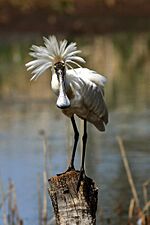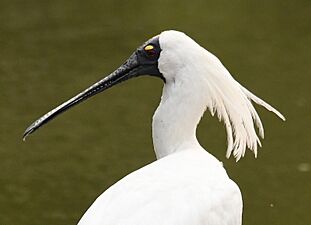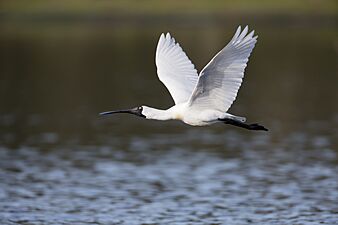Royal spoonbill facts for kids
Quick facts for kids Royal spoonbill |
|
|---|---|
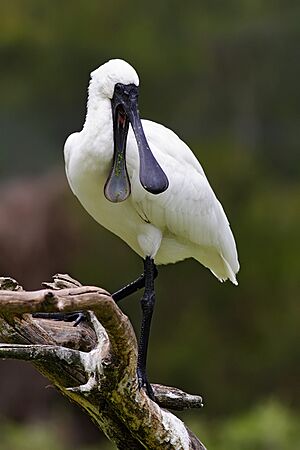 |
|
| Royal spoonbill with open beak | |
| Conservation status | |
| Scientific classification |
The royal spoonbill (Platalea regia) is a unique bird. It is also called the black-billed spoonbill. You can find these birds in wet areas like mudflats and shallow waters. They live in both fresh and salty wetlands.
Royal spoonbills are found in countries like Australia, New Zealand, Indonesia, Papua New Guinea, and the Solomon Islands. In New Zealand, people also call it kōtuku ngutupapa in the Māori language. Sometimes, a few birds might even visit New Caledonia.
These birds love wetlands. They eat small animals like crabs, fish, and insects. They catch their food by sweeping their special bills from side to side in the water. When they fly, they always keep their heads stretched out. The royal spoonbill is found in many places. Because of this, it is listed as "Least Concern" on the IUCN Red List. This means it is not currently in danger of disappearing.
Contents
About the Royal Spoonbill
The famous bird expert John Gould first described the royal spoonbill. He did this in 1838. He gave it the scientific name Platalea regia. He also noticed it looked a lot like the Eurasian spoonbill.
Scientists studied the DNA of spoonbills in 2010. They found that the royal spoonbill is very closely related to the black-faced spoonbill.
What the Royal Spoonbill Looks Like
The royal spoonbill is a big, white bird. It has a special black bill shaped like a spoon. This bird stands about 80 centimeters (31 inches) tall. Its wingspan is usually between 74 and 81 centimeters (29-32 inches). It weighs about 1.4 to 2.07 kilograms (3.1-4.6 pounds).
It is a wading bird, which means it has long legs. These long legs help it walk through water easily. It eats fish, shellfish, crabs, and amphibians. It catches its food by moving its bill from side to side in the water.
The end of the royal spoonbill's bill is wide. It works a bit like a pair of tongs. This is different from the yellow-billed spoonbill's bill. Their bill is narrower and works more like forceps.
How Royal Spoonbills Find Food
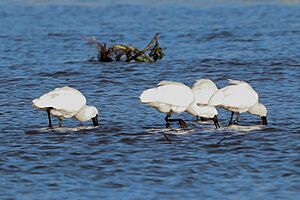
Royal spoonbills are meat-eaters. They find small animals by sweeping their bills through shallow water. When they find something, they quickly swallow it.
When they hunt slowly, they walk with their bill straight down into the water. The tip of their bill is open about 2 to 4 centimeters (0.8-1.6 inches). They sweep their bill in a wide arc in front of them. As they walk, they stir up the bottom of the water. This makes small animals come out. The spoonbill then senses and catches them with its bill.
If they find a lot of food in one spot, they will sweep that small area more carefully. Royal spoonbills also look for prey on plants underwater. They can even catch spiders above the ground. Sometimes, they drag their bills through the water next to them as they walk.
At Lake Cowal, they have been seen eating many different things. These include freshwater crabs like the common yabby and small shrimp. They also eat water insects, especially water bugs. Fish like mosquitofish and goldfish are also on their menu. Sometimes, they might eat freshwater snails or even a bit of plant material.
Royal Spoonbill Life Cycle
When royal spoonbills are ready to have babies, they change a bit. Long, white feathers grow from the back of their heads. Their faces also get colorful patches.
They build a nest that looks like an open platform. They make it from sticks in a tree. The female bird usually lays two or three eggs. The baby birds hatch after about 21 days.
These birds are very sensitive when they are nesting. If something disturbs them, they might leave their eggs. In Australia, whole groups of spoonbills have left their nests after a small scare.
Gallery



